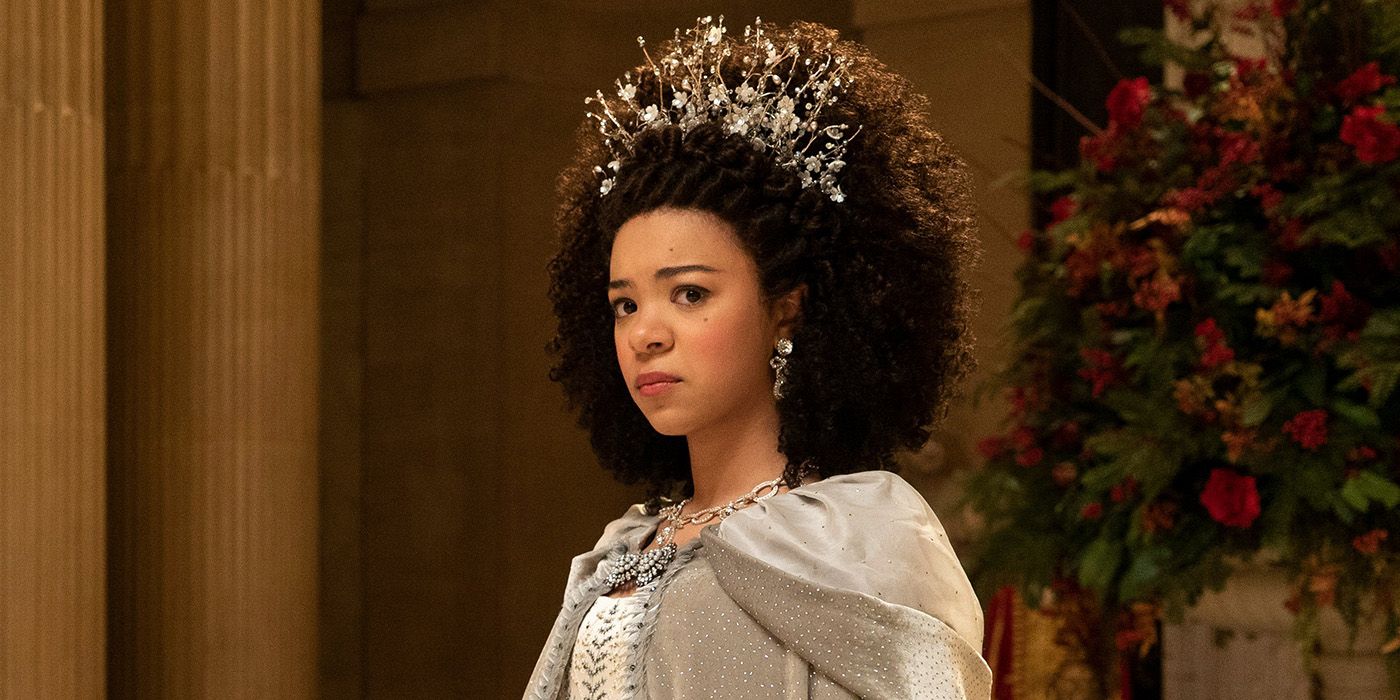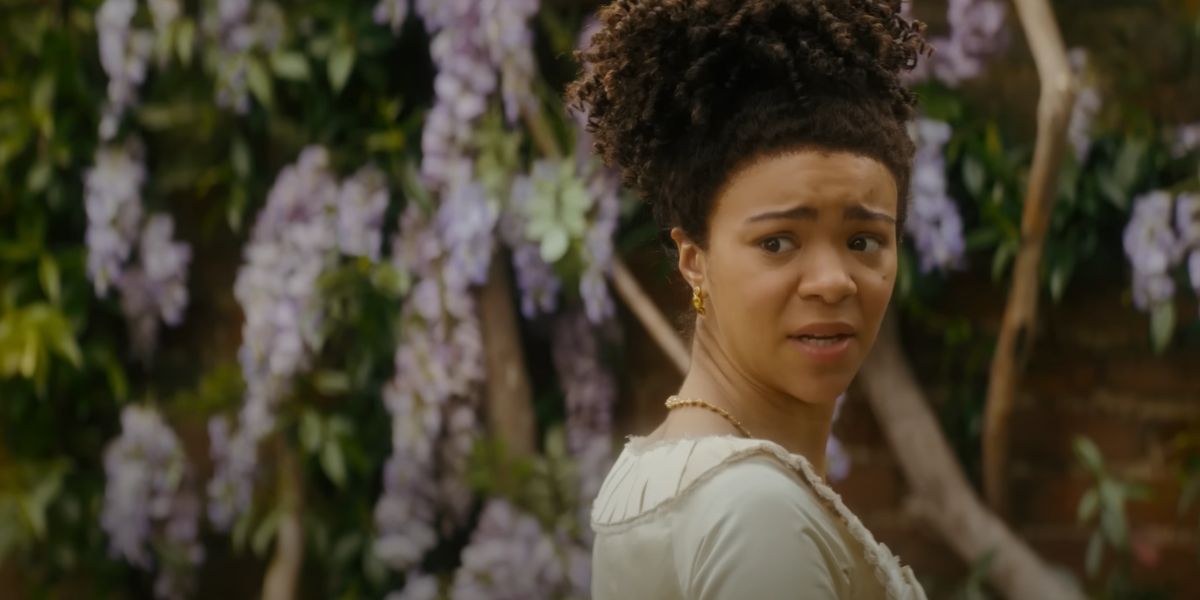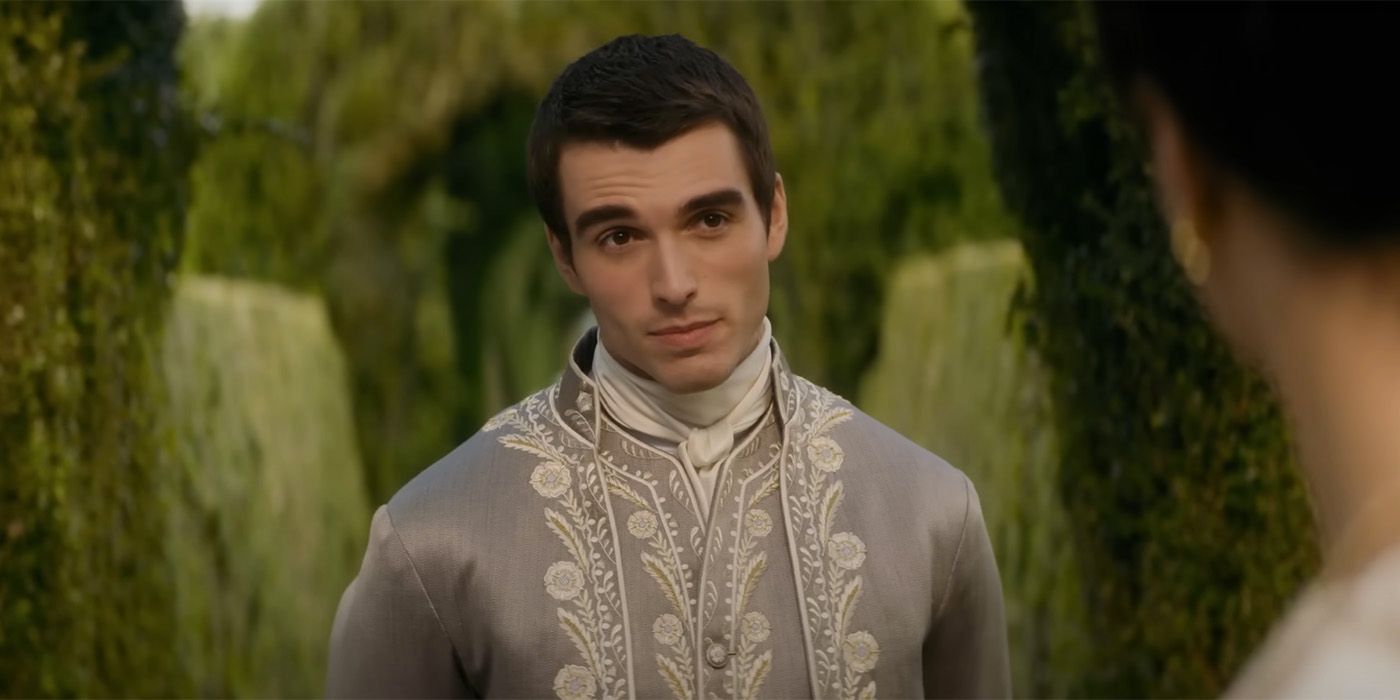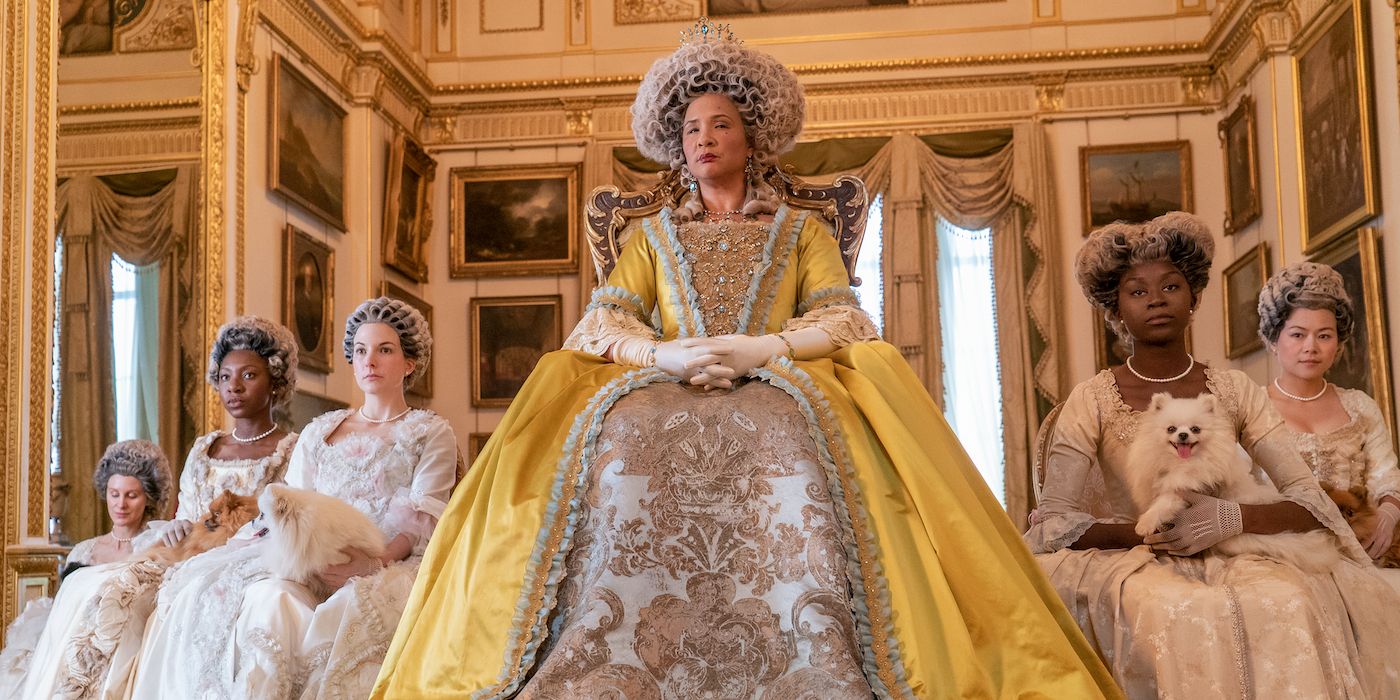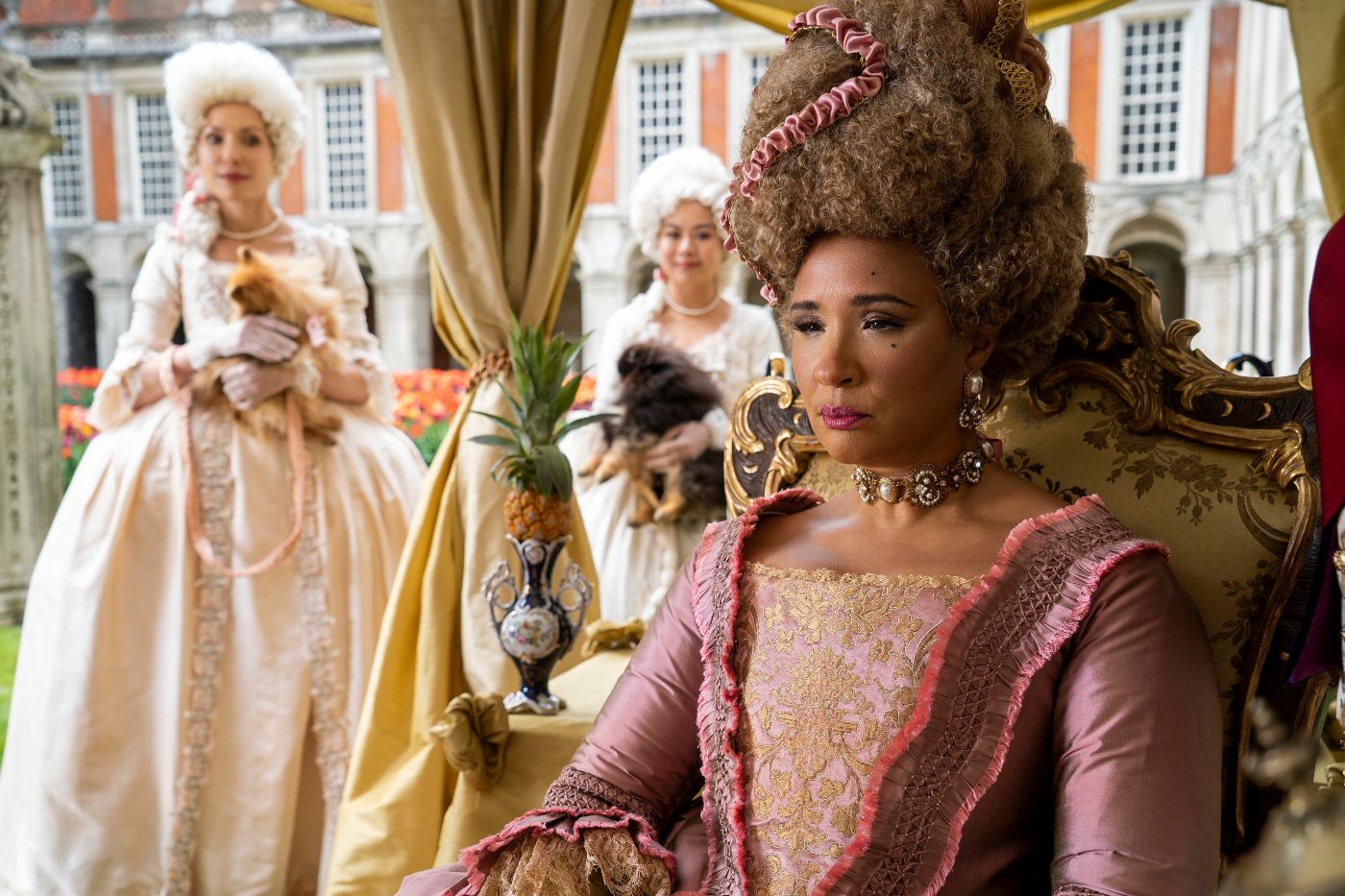When the first season of Bridgerton dropped on Netflix, a handful of characters quickly rose to the status of fan favorites in the eyes of the audience. After all, who could resist the charm of the Duke of Hastings (Regé-Jean Page), the anxiety-inducing energy of Penelope Featherington (Nicola Coughlan), or Eloise Bridgerton’s (Claudia Jessie) rebellious streak? But in this pantheon of beloved characters, there is one that stands the tallest: the keen-eyed and sharp-tongued Queen Charlotte (Golda Rosheuvel). Now, almost three years after making her first appearance in the Netflix hit romance series, Charlotte is getting her own show on the streamer, set to come out sometime in the Spring of 2023.
Produced by Shondaland, the same company responsible for Bridgerton, Queen Charlotte: A Bridgerton Story will star India Amarteifio as a younger version of the titular monarch. The show will chronicle Charlotte’s rise to power and her marriage to King George III (Corey Mylchreest). The character’s relationship with Lady Danbury (Arsema Thomas) and the Bridgerton matriarch, Lady Violet (Connie Jenkins-Greig), is also on the menu.
But while Queen Charlotte: A Bridgerton Story will certainly give us insight into who the queen really is in the Bridgerton universe, how much of her story in both shows is actually true? Who was the real Queen Charlotte? Here are a few things you need to know about the Regency queen before her new series comes out.
The Real Queen Charlotte Was Not Ready for Life at Court and Suffered Through 15 Pregnancies
Sophia Charlotte of Mecklenburg-Strelitz was born in 1744, in the northern German town of Mirow, in a small duchy of the Holy Roman Empire. She was the eighth child to Duke Charles Louis Frederick of Mecklenburg-Strelitz and Princess Elizabeth Albertina of Saxe-Hildburghausen, and, as such, her future wasn’t considered particularly promising. Little was taught to young Charlotte about the comings and goings of political life, and most of her education was devoted to domestic affairs. Thus, it must have been a real shock to 17-year-old Charlotte when she was thrown into the British court after her marriage to King George III, in 1761.
Just 22 years old at the time, George had just been crowned and was in dire need of a wife, as well as an heir. According to author Janice Hadlow, there was a mere six-hour-long interval between Charlotte’s arrival in England and her wedding ceremony. From 1761 to her death, in 1818, Charlotte would reign beside her husband as Queen of Great Britain and of Ireland. George would remain king for two more years after his wife's passing, up until his own death in 1820. But even though their marriage was long-lasting and reportedly very affectionate, things for the young queen would soon get a lot harder than anyone could have anticipated.
For starters, the queen had a pretty tough time with the producing heirs part of the job. Charlotte had a total of 15 children, of which 13 made it to adulthood. Being continuously pregnant took a toll on the young monarch, who once wrote, according to an excerpt of Janice Hadlow's The Strangest Family: The Private Lives of George III, Queen Charlotte and the Hanoverians quoted by the Smithsonian Magazine: “I don't think a prisoner could wish more ardently for his liberty than I wish to be rid of my burden and see the end of my campaign. I would be happy if I knew this was the last time”. At the time, she was pregnant with her 14th child, Prince Albert.
The deaths of two of her children due to smallpox also had a huge impact on the queen. According to Lady Charlotte Finch, who served as Prince Alfred’s nanny, Charlotte “cried vastly” after her son’s demise, in 1782. Six years later, the queen and king would suffer the loss of Prince Octavius.
During the Regency Period, Queen Charlotte Became Her Husband’s Guardian
But the worst was yet to come for Queen Charlotte. As England entered a period that is now considered by many one of the most romantic in history, the queen braced herself to face the biggest challenge of her long life as a monarch. In 1765, King George had his first temporary bout of madness, of which the queen was kept entirely unaware. However, in that same year, a bill was passed stating that Charlotte would be named Regent in case the king became unable to rule. This changed in 1788, when George became sick once again. The queen and her eldest son, Prince George, disagreed publicly about who should be made Regent. In the end, the Prince of Wales came out victorious. In 1811, when King George’s madness became permanent, it was his son that rose to the throne.
Charlotte, on the other hand, was made her husband’s guardian, a position she occupied up until her death.
However, her relationship with King George was forever changed by his mental illness. According to historian Catherine Curzon, during his episodes, the king made accusations of adultery against the queen and inappropriate comments about her attendants. Charlotte hid in fear of her husband after he physically assaulted their adult son, Prince George. She also stopped eating and sleeping and began tearing at her now graying hair. Desperately looking for answers, she called on doctor Francis Willis, who helped George recover his senses. Eventually, though, the treatments stopped working, and, as the illness progressed, Charlotte became increasingly incapable of spending time with her husband. So far, it is still unknown what exactly King George suffered from, though many historians believe his to be a case of either bipolar disorder or porphyria.
Queen Charlotte Was A Patron of the Arts and the First Queen in Buckingham Palace
But not all was tragedy in the life of Queen Charlotte, and it seems the series will linger more on the happier aspects of her early life. There were also moments of joy, especially before George’s illness settled in. One of them was definitely when the king and queen moved into Buckingham Palace. At the time of Charlotte’s marriage to George, the royal couple’s official residence was St. James Palace. However, this changed when the king acquired a property called Buckingham House. Queen Charlotte was completely taken by the new royal residence, and the couple moved into it in 1762, with Buckingham Palace becoming known as “The Queen’s House”.
Charlotte also had many interests to keep her busy during her time as queen. As shown in Bridgerton, the queen absolutely loved the social aspect of court. She was also a big fan of literature, botany, and, most of all, music. Charlotte became known for her support for famous composers, such as Georg Friedrich Händel and Johann Christian Bach, Johann Sebastian Bach’s son, and Queen Charlotte’s music master. In 1764, when George celebrated the fourth anniversary of his accession to the throne, an eight-year-old Wolfgang Amadeus Mozart was invited to perform for the king and queen. One year later, Mozart would dedicate his Opus 3 to Queen Charlotte.
Was Queen Charlotte Indeed Britain’s First Black Monarch?
Ever since the amazing Golda Rosheuvel popped up on screen on Season 1 of Bridgerton, fans of the series have been rehashing an old historical debate: was Queen Charlotte the first Black or bi-racial person to sit on the English throne? Well, the answer isn’t as clear as many would desire. There is indeed evidence that points to the queen having some African ancestry on her Portuguese side of the family. According to historian Mario de Valdes y Cocom, Charlotte “was directly descended from a black branch of the Portuguese royal family, related to Margarita de Castro e Souza, a 15th-century Portuguese noblewoman nine generations removed, whose ancestry she traces from the 13th-century ruler Alfonso III and his lover Madragana, whom Valdes takes to have been a Moor and thus a black African.” Valdes y Cocom also points to a note written by one of Her Majesty’s physicians, Baron Christian Friedrich Stockmar, as evidence of her African ancestry. According to the doctor, the aging queen was "small and crooked, with a true mulatto face".
But was this indeed a reference to her race or just a rude comment made by a very racist 18th-century British noble? Many believe it might be the latter. Historian Ania de Loomba, for instance, explains that “The word 'blackamoor' in Shakespeare's time meant Muslim. It didn't mean black necessarily. Moors could be white from North Africa.” Besides, even if Queen Charlotte was Black, she wouldn’t necessarily be Britain’s first Black monarch. There’s a similar debate surrounding the ethnic background of Philippa of Hainault (1314-1369), consort of Edward III. In the end, there’s just no way of knowing. All we can be certain of is that Queen Charlotte was a complex woman with an interesting, complicated life. Oh, and that Gold Rosheuvel and India Amarteifio both look great in her shoes.

